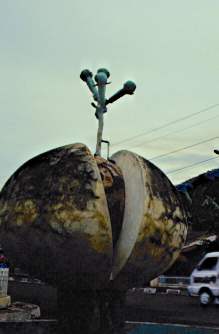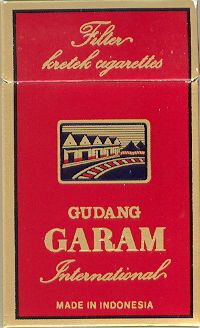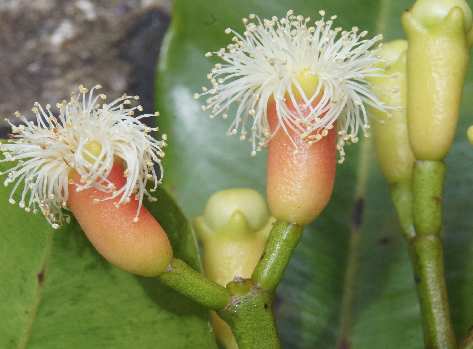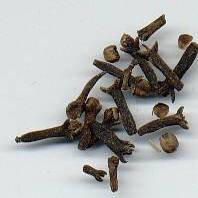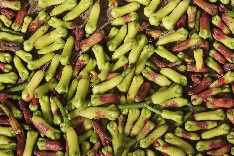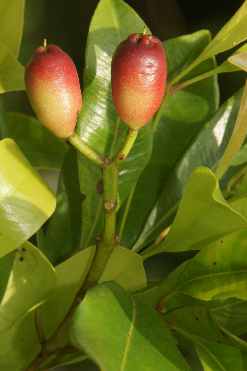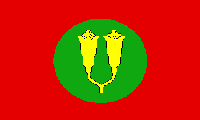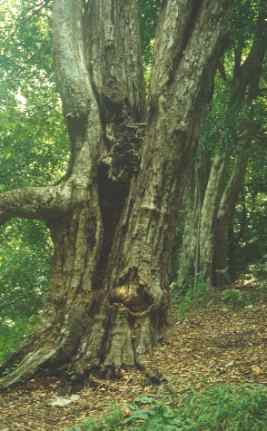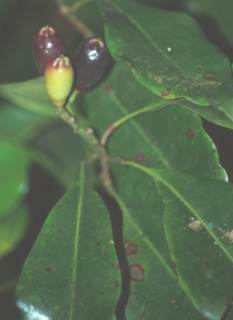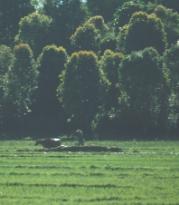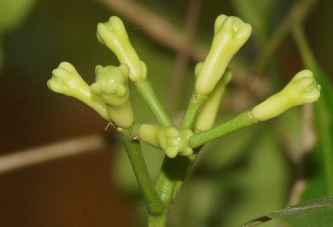influenced tongues have a different word for
clove: German Nelke, Norwegian nellik,
Danish nellike, Icelandic negull,
Swedish neijlikor,
Yiddish negelen [נעגעלען],
Finnish neilikka, Estonian nelgi and
Sranan nagri. These are related to German Nagel,
nail
.
Nail and its cognates in Germanic languages (Old High German nagal,
English nail, Icelandic nagli, Swedish nagel)
basically means either nail of finger or toe
or slim pointed piece of
metal
; the second meaning is younger and does not appear outside the Germanic
languages: Old Irish ingen, Latin unguis
nail
, Latvian nags hoof
, Greek
onyx [ὄνυξ] claw
,
Sanskrit anghri [अंघ्रि] foot
.
The vowel variations made reconstruction of the Proto-Indo–European root behind all these forms somewaht difficult, but laryngal theory suggests H₃NOGʰ or H₃N̥Gʷʰ (with possible extensions) nail, claw
as a reasonable guess.
Cloves are named nail spice
in other languages, too; for example, take
Russian gvozdika [гвоздика]
which comes from gvozd’ [гвоздь] nail
.
As another example, one finds a group of related names in Western to Central Asia:
Georgian mikhak’i [მიხაკი],
Azeri mixək and
Farsi mikhak [میخک]
belong to the same kin as Azeri mıx and
Farsi mikh [ميخ] nail
.
Similar names for nail
are found in several Turk languages
(Turkish mıh and Uighur mih),
suggesting that the name is ultimately of Altaic origin.
|
|
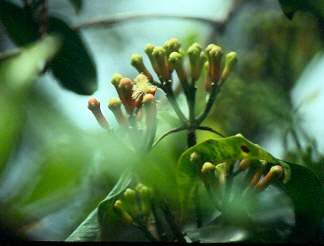
| |
Clove flowers
|
|

|
|
Unripe clove buds
|
In the same spirit, Hebrew
tsiporen [ציפורן]
also has two meanings fingernail
and clove
, although it is not
related to any of the former mentioned languages. In its Old Hebrew form
tsipporen [צפרן, צִפֹּרֶן],
that word also appears in the Old Testament, but only in the meanings
finger nail
and tip, point
, not in reference to the spice.
It is believed that cloves came to the Mediterranean no sooner than the
first or second century B.C.

|
|
Unripe clove buds
|
Another unrelated language names cloves as nails
: Basque
iltze-kanela literally means cinnamon nails
(iltzatu nail
); so the spice was named both for its
shape and, even if inaccurately, for its fragrance (it can also be called iltzea for short). See
Indonesian cinnamon for the etymology of the
second part of this name.
German Gewürznelke, Dutch kruidnagel
or Swedish kryddnejlikor are emphatic formations meaning
condiment clove
. For the determinative elements in these compounds, see
mugwort for the German and savory for the Dutch and Swedish names.
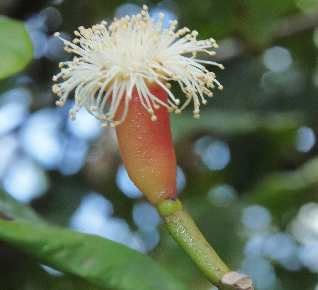
|
|
Clover flower close-up
|

|
|
Clove flower
|
In Old Greek, the clove spice was known as karyophyllon [καρυόφυλλον],
which appears to be a compound of two Greek nouns:
karyon [κάρυον] nut
and phyllon [φύλλον] leaf
.
Yet such a compound is poorly motivated: Clove is neither nut nor leaf, and
does not even look so. Moreover, practically all names of foreign spices in
Greek tongue are loans from languages of the trading peoples (see
cinnamon, long pepper,
cassia, sesame,
ginger and malabathron
for examples). So I suspect that karyophyllon is, in fact, a
corrupted name of cloves in a tongue of South or South East Asia, probably
India. For example, there is the Sanskrit name
katuka phala [कटुक फल] pungent fruit
(or pungent nutmeg
)
given to an unidentified aromatic plant (both elements of this name have no Indo–European etymology,
and it is supposed that they stem from an unknown Indian language, possibly Dravidian or Munda).
Since cloves would probably have been traded in the seaports of South India, it is interesting
to note that the modern Dravidian languages still have remarkable similar
names with a consonant pattern K–R–[PB]: Tamil karambu [கராம்பு],
Malayalam karayanpu [കറയാന്പൂ] and also
the Indo-European Singhalese karabu [කරාබු]. Malayalam even shows the
palatal glide present in the Greek word, in the right position.
The search for a possible source of Greek karyophyllon yields further hits in all major language families of South East Asia:
Thai kanphlu [กานพลู],
Lao kanphu [ກ້ານພູ],
Khmer klampu [ក្លាំពូ] and
Tagalog klabong. While it would be tempting to add Japanese kurobu [クローブ]
to that list, this name is just a modern adaption of the completely unrelated English clove as it is sometimes found on the net; the traditional Japanese name of clove derives from Chinese (see below).

|
|
Sterile branch of clove
|
Karyophyllon [Καρυόφυλλον] is not only direct
progenitor of modern Greek garifalo [γαρίφαλο]
clove
, but was also, via Latin gariofilum, transferred
to some present-day Romance languages, e. g., Italian garofano,
and French girofle. Further related words for clove are
Turkish karanfil,
Serbian karanfilić [каранфилић],
Bulgarian karamfil [карамфил],
Kazakh qalampır [қалампыр],
Dhivehi karanfoo [ކަރަންފޫ],
Swahili karafuu and several Semitic names, e. g.,
Arabic al-qaranful [القرنفل]
and Amharic krinfud [ቅርንፉድ].

| |
Sterile branch of clove
|
|

| |
Branch with clove flowers
|
|

|
|
Young clove buds
|
In some languages, cloves share the name with the fragrant ornamental
carnation or pink (Dianthus caryophyllatus), e. g.,
German Nelke, Italian garofano,
Greek garifallo [γαρύφαλλο],
Belarusian gvazdziki [гваздзікі]
and Russian gvozdika [гвоздика].
In English, the ornamental is also known as gillyflower which is
etymologically related to Greek karyophyllon and thus
akin to all the names mentioned in the previous paragraph.
Another group of names for clove are found in India, e. g.,
Pashto and Urdu lung [لونګ, لونگ],
Kashmiri rong [رونگ],
Hindi and Punjabi laung [लौंग, ਲੌਂਗ],
Gujarati laving [લવિંગ],
Bengali labango [লবংগ]
and Telugu lavangalu [లవంగము].
These names have no discernible etymlogy in the Indo–Aryan (or Dravdic) languages and are in all likelihood loans;
they might be distantly related to the group of karyophyllon and kanplu.
I found the suggestion that they derive from a Malaiic language, which would bring us again to the vicinity of Tagalog klabong.
Note, however, that cloves are called cengke in both modern Indonesian and Malay.
The Tamil and Malayalam names ilavangam
[இலவங்கம், ഇലവംഗം]
are part of the group of names quoted in the previous paragraph. Surprisingly,
their prime denotation is cinnamon tree
,
although, according to dictionaries, they may mean clove
on occasion. Such behaviour
again points to these names being loanwords that just got attached to whatever aromatic comes first to the mind;
also, these languages use an epenthic i regularly whenever a loanword starts with a consonant (such as L,R) or cluster that
is not allowed word-initially.
The botanical genus name Syzygium derives from Greek
syn [σύν] together, with
and
zygon [ζυγόν] yoke
(from zeugnynai [ζευγνύναι] join
).
The name refers to the petals, which are merged (joined) into a cap-like structure. Being fused, they cannot open at the onset of flowering but seperate from
the plant and fall to thee ground; the showy
part of the flower is made entirely of the anthers.
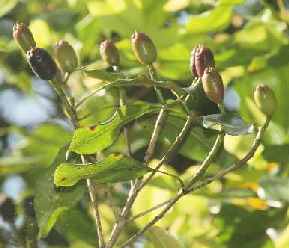
|
Clove berries (mother of clove )
|
The Chinese term for cloves is ding xiang [丁香],
also transcribed ting hsiang and in countless other variants. Similar to English (which has the gillyflower
complication and other European tongues, Chinese uses the same word for a fragrant ornamental flower, in this case lilac (Syringa spp.).
In Chinese, the lilac genus is termed ou ding xiang [欧丁香], roughly European clove
,
and the single species get compound designations, e. g., bao ma ding xiang [暴马丁香]
for the species native to East Asia (S. reticulata). In the meaning clove
, the word was
was transferred to Vietnamese as dinh huong [đinh hương]
and to Korean as chong-hyang [정향]
The second element xiang [香]
means spice, fragrance
and is often found in the names of
aromatics or well-flavoured foods; it also forms the first part in the toponym Hongkong
(Cantonese heung gong [香港],
Mandarin xiang gang [香港] fragrant harbour
).

|
|
Ship model made from dried cloves (handicraft of the Moluccas)
|

|
Clove berries (mother of clove )
|
The first part of that name, ding [丁],
typically means small thing, chunk
; it also denotes a specific cutting technique
to chop meats into rather small pieces, and a male surname; it does not mean nail
. Yet, I think
that the original meaning of ding xiang might also have been nail spice
:
First, the shape of the Chinese character 丁 evolved from a nail,
and the modern language has a homophonous word ding [钉] nail
(the
nail
character is composed of jin [金] metal
with the phonetic complement ding [丁]
and thus means a thing made from metal and spoken ding
).
Second, the Korean chong-hyang is written 釘香
in the now obsolete Sino–Korean writing, using the traditional variant of the nail
character.
Perhaps, such a spelling was also possible in an earlier stage of Chinese, although
钉香 is not valid in the contemporary language.
As usual, the situation is even more complicated in Japanese. There is a term spelt identically to the Chinese and pronounced
cho-ko [丁香, ちょうこう, チョウコウ].
But this is less commonly used than cho-ji [丁子, 丁字, ちょうじ, チョウジ],
which has two Kanji spellings (the first one is more frequent). The Kanji at the second position just means small thing
.
Selected Links
Indian Spices: Cloves (indianetzone.com)
Ilkas und Ullis Kochecke: Nelke (rezkonv.de via archive.org)
A Pinch of Cloves (www.apinchof.com)
The Epicentre: Cloves
Chinese Herb Database: Cloves
Medical Spice Exhibit: Cloves
chemikalienlexikon.de: Acetyleugenol
Transport Information Service: Cloves
Sorting Syzygium names (www.plantnames.unimelb.edu.au)
The Mythic Chinese Unicorn zhi: The Cinnamon Route (via web.archive.org)
The Economist: A Taste of Adventure
